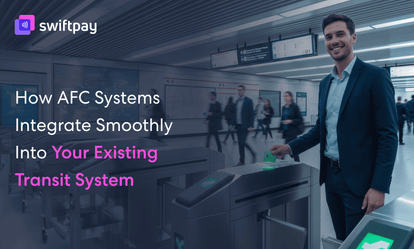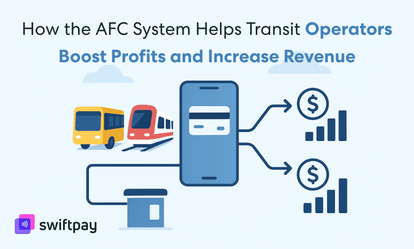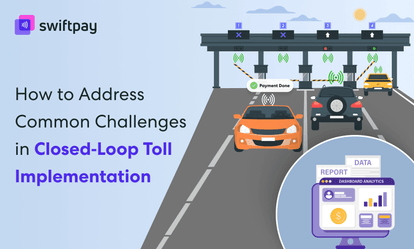Here’s a hard truth for toll operators: traditional payment systems aren’t just slowing down road users—they’re costing you as well.
Research shows that inefficient toll collection processes can lead to operational inefficiencies that drive up costs.
Besides, congestion at toll plazas remains one of the top contributors to users’ dissatisfaction. And let’s not forget the ripple effects: manual cash transactions are prone to errors, long queues frustrate drivers, and high maintenance costs eat into already tight budgets.
But it’s not all doom and gloom. The tech to fix this isn’t some distant dream—it’s here, and it’s called closed-loop payments.
These systems are designed for efficiency: they automate toll collection end-to-end, slashing wait times to mere seconds, cutting operational inefficiency, and handing drivers a smoother ride without the hassle.
Plus, closed-loop toll payments don’t just streamline transactions; they reinvent the entire tolling experience.
So, if you want streamlined toll operations and happier users who aren’t cursing your name then keep on reading. Here’s what you’ll learn:
- How closed-loop payments address the root causes of toll plaza congestion
- The cost-saving and operational advantages of closed-loop toll payments
- Why drivers prefer this seamless approach—and how it boosts satisfaction
Let’s dive in.
The challenges of traditional toll collection methods
Below are some common challenges that toll operators like you face on a day-to-day basis:
High operational costs
Manual toll collection costs you big. You need staff at every booth, cash processes that eat time, and constant fixes for old equipment.
Cash payments are risky and prone to errors, and each payment from bank cards takes about 1.5-2% fees. Add that up over millions of transactions, and it’s a steady drain on your profits.
Traffic bottlenecks
Cash payments take forever—15 to 30 seconds per vehicle, while electronic payments zip by in under 3 seconds.
During busy times, that delay stacks up fast. Lanes back up, drivers wait, and your toll booth turns into traffic traps that stretch onto highways.
Lack of real-time traffic insights
Traditional toll systems give you no data. You don’t know when traffic spikes, how drivers act, or what’s causing congestion in your lanes. Without vehicle insights, you’re guessing on pricing and staffing. That’s a shaky way to run things.
Customer frustration
Long lines, incorrect charges, and payment glitches annoy users. They don’t stick around for that. If there’s a toll-free road nearby, they’ll take it—and you lose money. Bad experiences drive customers away fast.
What are closed-loop payment systems in toll collection?
Closed-loop payment systems are dedicated financial ecosystems where users pre-load funds into an account that can only be used within their toll network.
Unlike credit cards that connect to external banking systems, closed-loop toll payment systems keep transactions, data, and revenue fully within your control.
How closed-loop toll collection systems work
Closed-loop payments make toll collection smooth and fast. You might wonder how they actually work on your plazas.
Here’s the process, broken down into simple steps so you can see exactly what happens—and why it beats the old ways.
Step 1: Users get a prepaid account
It starts with users signing up for an account with your toll system. They add money to it upfront—think of it like a closed loop prepaid card or e-wallet. No bank cards or cash are needed at the plaza, just a loaded account ready to go.
Step 2: A tag or app links to the account
Each user gets a small tag for their windshield or an app for their phone. This connects straight to their prepaid account. It’s their ticket to pay without stopping.
Step 3: Sensors spot the tag or app at the plaza
As a user rolls up to your toll lane, sensors overhead pick up the tag (usually RFID) or phone app. The system knows who they are in a split second.
Step 4: Money moves from account to you
The sensor talks to your system, and the toll fee gets pulled from the driver’s prepaid account. It happens instantly—usually in under 2 seconds—and the cash lands in your hands without any staff stepping in.
Step 5: Drivers top up when needed
When users’ account runs low, they can add more money online or at a kiosk. They stay in the loop, and you keep collecting without a hitch.
Difference between open-loop and closed-loop payments in toll collection
The table below shows the key differences between open-loop and closed-loop toll payment systems.
| Aspect | Open-Loop Systems | Closed-Loop Systems |
|---|---|---|
| Payment Processing | Relies on external payment networks (Visa, Mastercard, etc.) | Self-contained within your toll network |
| Transaction Fees | 1.5-3% per transaction plus flat fees | Minimal or none |
| Data Ownership | Limited access to customer data; owned by banks | Complete control over all customer and transaction data |
| Revenue Control | Money flows through external financial institutions | Funds remain in your ecosystem until spent |
| Fraud Risk | Higher due to external factors | Reduced due to secure authentication |
Key benefits of closed-loop payments for toll operators
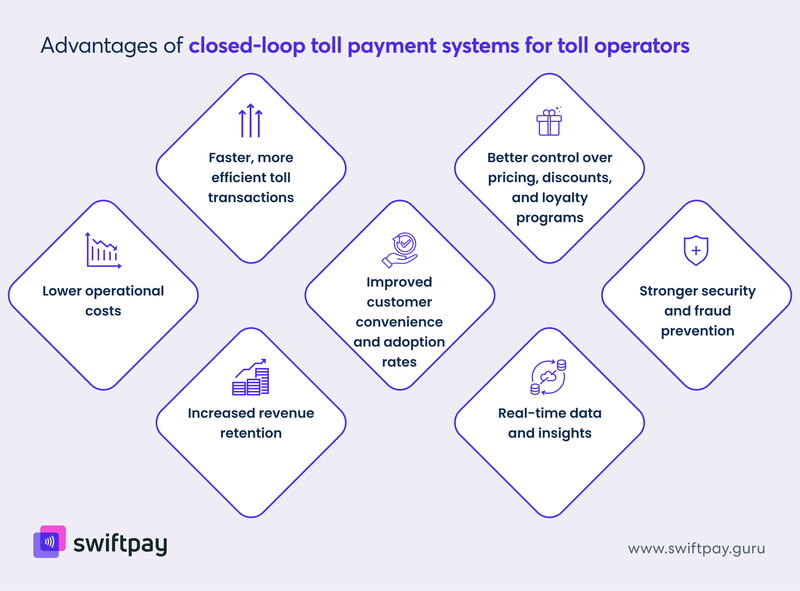
The shift from traditional payments to closed-loop toll collection doesn't just solve existing problems—it creates new opportunities for operational excellence and customer engagement.
Here's how these systems deliver value across multiple dimensions for toll operators like you:
Faster, more efficient toll transactions
Closed-loop payment systems eliminate the transaction friction that causes bottlenecks. With cash handling and card authorization delays removed, vehicles move through toll points without stopping (and only a minor stoppage of around 5 seconds in case your toll has barriers).
Automatic account debits enable true drive-through experiences where vehicles maintain speed while tolls are collected invisibly. This seamless flow doesn't just please customers—it allows you to collect tolls from more vehicles per hour with the same physical infrastructure.
Besides, the reduced congestion leads to better traffic management across your entire network.
Lower operational costs and increased revenue retention
Unlike credit and debit transactions that incur 1.5-3% fees per transaction, closed-loop toll payments eliminate these costs entirely.
For a toll operation processing $10 million annually, this difference alone represents $150,000-$300,000 in direct savings.
The pre-loaded nature of closed-loop e-wallet accounts virtually eliminates chargebacks and fraud risks that plague open-loop systems. When funds are already secured in your ecosystem, payment disputes become rare events rather than daily headaches.
Apart from that, administrative costs plummet as cash handling, counting, reconciliation, and armored car services become unnecessary.
Improved customer convenience and adoption rates
Contactless payments via RFID tags, windshield-mounted transponders, or mobile apps create frictionless experiences that users quickly prefer over alternatives.
Prepaid accounts simplify budgeting for both occasional and frequent travelers. Users gain visibility into their spending patterns and control over their transportation costs. These benefits boost customer satisfaction significantly.
Moreover, automatic balance notifications and top-up features prevent the frustration of insufficient funds. These proactive measures dramatically reduce negative experiences while ensuring continuous revenue flow.
Better control over pricing, discounts, and loyalty programs
Closed-loop toll collection systems enable dynamic pricing models based on:
- Real-time traffic conditions
- Time of day
- Vehicle classifications
This flexibility optimizes both traffic flow and revenue generation—a capability that simply doesn't exist with static toll collection.
With these systems, frequency-based discounts become easy to implement and track, which improves retention among your most valuable customers.
You can also create compelling reasons for users to choose your routes consistently over alternatives by custom loyalty incentives such as:
- Bonus credits
- Free passages after reaching thresholds
- Partner discounts
Stronger security and fraud prevention
Closed-loop toll payments eliminate the security risks inherent in handling card data or cash. With no payment information transmitted to external networks, the risk of data breaches drops significantly.
These systems also provide advanced encryption and user authentication to prevent unauthorized access and transaction disputes. The result is a dramatic reduction in fraud-related losses and administrative time spent resolving payment disputes.
Besides, cash handling risks—from counterfeit currency to employee theft—disappear entirely. Hence, it removes both financial and security concerns that plague traditional toll operations.
Real-time data and insights for smarter toll management
Closed-loop toll payment systems generate comprehensive data on:
- Traffic patterns
- Peak usage times
- Revenue trends
These valuable insights can help you make strategic decisions about your operation and services. This visibility transforms toll management from reactive to proactive.
Using AI-driven analytics can help you process this data to optimize pricing, staffing, and infrastructure investment. Plus, the resulting insights deliver improvements in operational efficiency.
Also, its integration potential with smart city initiatives and broader transportation networks positions your toll operation as an essential component of regional mobility solutions rather than just a revenue collection point.
How closed-loop payments improve user experience
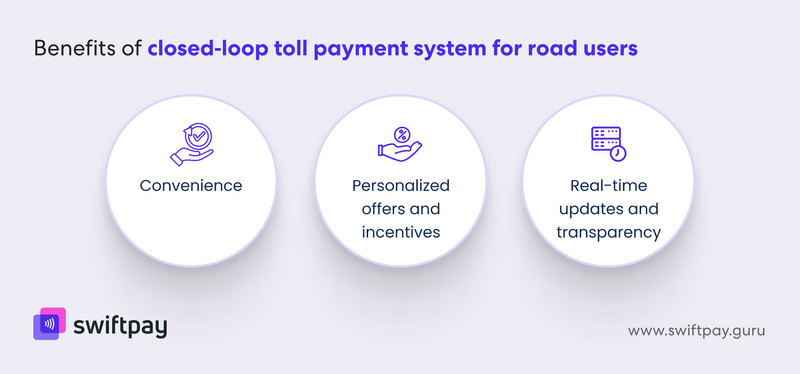
Beyond operational benefits, closed-loop systems significantly enhance the driver experience—turning tolls from necessary inconveniences into seamless interactions.
Convenience for drivers
Electronic tags and mobile apps eliminate the need for cash, change, or manual ticket issuance. Users save an average of 3-5 minutes per toll plaza during peak hours—time that adds up quickly for frequent travelers.
The feature automatic balance reload ensures uninterrupted travel without the embarrassment or delay of insufficient funds. This simple feature dramatically improves perception of your toll system's reliability.
Personalized offers and incentives
Closed-loop toll payment systems enable targeted discount programs based on usage patterns or time of travel. Commuters would welcome reduced rates during off-peak hours.
Apart from that, these systems also allow toll operators like you to introduce subscription models like monthly passes or bulk-purchase discounts. This creates predictability that both personal and commercial users value.
These programs also boost usage rates by making your toll routes the obvious economic choice.
Enhanced customer communication and transparency
Closed-loop e-wallets for toll can provide real-time notifications about toll charges and immediate transaction confirmation, which eliminates uncertainty about when and how much road users pay. This visibility builds trust in your system.
Moreover, account dashboards and trip histories give users complete visibility into their toll usage patterns. This transparency ensures that users are not paying any hidden charges, and they can also predict their expenses based on past transactions.
Conclusion
Closed-loop toll payment systems deliver proven benefits for toll operators like you who are seeking efficiency, cost reduction, and improved customer experiences.
The advantages of these systems extend beyond simple transaction processing to create strategic opportunities for growth and innovation.
Hence, it should be beyond any doubt that toll operators who implement closed-loop payment solutions for toll collection position themselves to reduce operational costs, increase revenue retention, and deliver the seamless experiences that modern road users expect.
Your toll operation doesn't need to settle for the limitations of traditional collection methods or the high costs of open-loop alternatives. Closed-loop payment systems offer the perfect balance of control, efficiency, and customer satisfaction.
Contact SwiftPay today to explore how our purpose-built closed-loop payment solutions can transform your toll operation from a traffic bottleneck into a model of modern efficiency.



